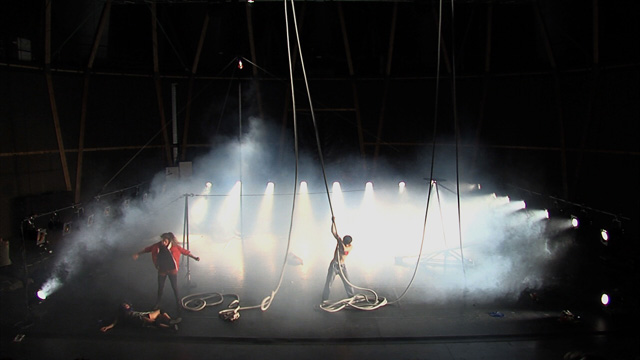Review from: CircusFest, Roundhouse, London; 19th April 2018

Heading into the Roundhouse’s main space for the much hyped Bekkrell Effect I found myself doing something I almost never do – reading the programme explaining what the show is ‘about’. Usually I like to take in a show first, and then refer to any printed information to see if what I drew from the work was broadly in line with the artists’ intentions. For this show however, the contextualising information provided in the programme didn’t help me to understand what occurred on stage outside the central concepts of chaos, destruction and reconfiguration. There is much to marvel at within Groupe Bekkrell’s show, but I can’t help but feel like I missed some sort of crucial element or connection. Perhaps this is just not the show for me, perhaps the hype surrounding it had set my expectations too high, perhaps I am not well versed enough in the complex language of contemporary French circus theatre, or maybe my personal tastes are simply too narrow to fully appreciate this work. I didn’t enjoy this show – but neither did I not enjoy it.

Opening with a deconstructed set strewn across the stage, I can see the infrastructure for a tightwire, a huge rope suspended in a pulley system, and the parts for a Chinese pole. The performance begins under full house lighting, and the cast of four tweed-clad women with knee pads stride on and make preparations to build the set (now Chloe Derrouaz and Louisa Wruck alongside original company members Sarah Cosset and Fanny Sintes). Pleasingly, they are not wearing the skimpy outfits or conspicuously ‘cool’ jeans and tank top costuming that has come to typify much contemporary circus. Instead they look to my mind more like the illustrations of Quentin Blake – sketchy, textured, unique and characterful. Indeed, one of the most notable and intriguing aspects of Bekkrell Effect is the fact that they are an all female company who have chosen to make work which does not focus on gender, which is certainly a refreshing addition to the circus landscape. I can’t recall seeing a show where women are so in charge of their own physicality without any reference either to men or to societal notions of ‘femininity’. By choosing to work with a concept which sits outside of a social or anthropological framework they have created a space where they can simply exist, and demonstrate their creativity freely.

Filled with curiously choreographed dance breaks, random interactions and an overall sense of playfulness, there is a lot fun to be had in watching the show. However searching for patterns and motivations for the action is difficult and, depending on your preferences as an audience, you will find yourself either revelling in or being frustrated by the lack of any sense of narrative, or even coherent characters. Sometimes these absurd set-ups pay off, however it took me an embarrassingly long time to realise that the garbled language the cast mumble throughout the opening sequences was as a result of them all wearing gum shields. The often incomprehensible, neanderthal-esque grunts and articulations elicited some laughs from the crowd, and were ultimately subverted in a gloriously surreal moment when one artist spits hers out and is only able to recite Shakespeare.

Throughout the show, the set is built, dismantled, explored, rebuilt and reconfigured, and there are some notably impressive visual moments, including the entire teeterboard being counterweighted up into the ceiling and one of the artists suspended midair in a cats cradle of rope tensioned across the whole space. This chaotic and playful use of the equipment is certainly exciting to watch, and perhaps to someone less used to seeing circus performances it may look like an incredible and inventive way to integrate human physicality with a built environment – which it absolutely is, however most of what I saw was equipment being underused. Perhaps I am more of a circus purist that I thought, because one of the things that struck me most about this show was my disappointment at the lack of recognisable technical circus executed to a level that conveyed meaning to me, and how much I had expected there to be some. Perhaps because of the prestigious training backgrounds of the artists, or perhaps because the nature of the equipment being used I had the expectation that at some point there would be a kick-ass teeterboard sequence or group acro number to compliment the theatrical and conceptual elements of the show, but they sadly never materialised. The technical circus that is present is good, particularly the Chinese pole, and perhaps it is purely down to my own personal expectations and biases that I wanted more.

In contrast, the lighting design, soundscape and technical aspects of this show cannot be overstated and are sublime in their complexity, adding a real air of depth and gravitas: lighting rigs fly up and down as much as the artists do, and in one section the equipment is mic’ed, creating an eerie, resonant connection between the artists physicality, each other, and the space as a whole. The final image, where the four cast members combine all of the equipment on stage into a makeshift raft and haul both it and themselves up into the air in a tangled mass, gives the sense of a moment of implosion which acts as a deeply satisfying end to the overall aesthetics of the work.
In many ways it feels like Bekkrell Effect is a show of contradiction and subversion; a show foregrounding women with no reference to gender, a circus show where ‘circus’ is reconfigured, a show where language is disarticulated, and senses of ‘structure’ are wholly undermined. In conclusion, I feel that I can only refer back to the beginning; I am not sure if I enjoyed this show, but I am pleased to have experienced it.
.




